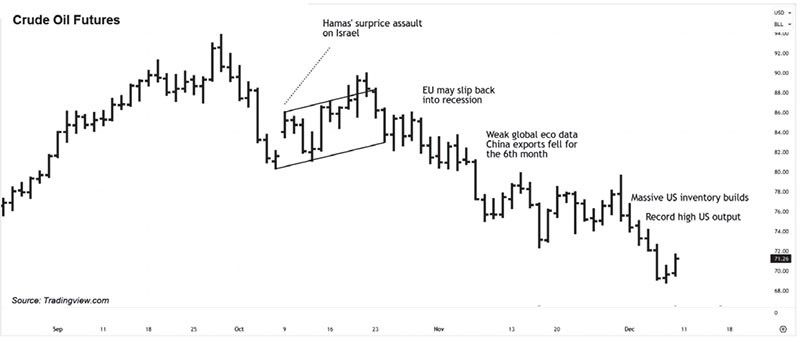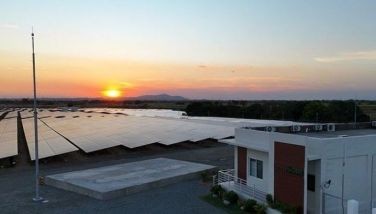Oil’s downward spiral

The continued decline in oil prices has left many investors surprised. Despite heightened tensions stemming from the Israel-Hamas conflict and concerted efforts by OPEC+ to support oil prices, the market remains entrenched in a downward spiral.
Since its peak on Sept. 28 at $93.82 per barrel, oil prices have plummeted by 25 percent. The past week saw a close of $70.36 per barrel, marking seven consecutive weeks of decline. This is oil’s longest weekly losing streak since 2018.

Slowing global oil demand
The slowdown in global economic growth across different regions has put pressure on oil demand. The EU has faced hurdles in economic recovery. China has grappled with its real estate crisis and concerns regarding its financial sector’s stability. Japan’s economy contracted 2.9 percent in the third quarter, signaling broader economic challenges. Meanwhile, recent data in the US indicates a cooling trend in consumer spending, inflation, and labor market activity.
Crude slides despite OPEC+ cuts
The surprising response of crude oil prices following the announcement of OPEC+ extending supply cuts into 2024 highlights a shift in market dynamics. In the past, such announcements often led to price spikes. But this time, the market responded differently. Following OPEC+’s announcement of supply cuts on Nov. 30, oil prices declined 11 percent.
Signs of dissent in OPEC+?
Internal tensions within OPEC+ are centered around production cuts. While Saudi Arabia independently reduced output by one million barrels in July, continued cuts in 2024 may burden smaller members. The postponement of the original Nov. 26 meeting and dissent from countries like Angola and Nigeria, which are pushing for higher production allotments, illustrate the complexities within the group. This could impact the group’s ability to maintain consensus on future production policies.
Shadow fleet
According to Bloomberg reports, Russia allegedly channeled 45 percent of its oil sales through shadow fleets, aiming to bypass Western sanctions restricting its oil revenues. Despite the price cap on Russian oil and the prohibition of Western maritime shipping and insurance, a substantial number of aging tankers have transformed into shadow fleets. These vessels operate outside the reach of Western regulators, likely with inadequate insurance coverage. Primarily, these clandestine shipments are suspected to be bound for destinations in China and India.
Record US crude oil production
The remarkable increase in US crude oil supply has been a game changer. Hitting 13.2 million barrels per day solidifies the US as the world’s largest oil producer. The International Energy Agency (IEA) notes that the US contributed 80 percent of this year’s global oil supply growth. This surge has notably depressed oil prices, impacting OPEC+ efforts to regulate prices via production cuts. Additionally, it has emboldened the US to start repurchasing oil and refilling its Strategic Petroleum Reserve (SPR).
US shale disrupts OPEC+
The rapid scalability of US shale production, particularly from shale reserves, poses a direct challenge to OPEC+’s conventional strategies. As prices surge due to OPEC+ production cuts, it incentivizes US shale producers to ramp up their output, potentially undermining OPEC+’s intended pricing impact. Since the oil price wars of 2014 to 2016, the US shale industry has undergone consolidation, making it more resilient and efficient. Implementing cost-cutting measures, leveraging advanced technology, and focusing on the most productive regions have made shale producers more resilient compared to previous years.
A boon for the Phl
The drop in oil prices is a boon for the Philippines, a nation heavily reliant on imported oil. The reduction directly contributes to lowering inflation and narrowing trade deficits. Filipino consumers benefit from lower transportation costs, reduced power and utility bills, and higher purchasing power. Lower oil prices is also one of the reasons why the peso appreciated from 57 in October to about 55.50 in recent weeks.
Soft landing or recession?
Most economists are forecasting a soft landing in 2024. The S&P 500 index reached new highs just last week, buoyed by optimism around slowing inflation and potential rate cuts by the Fed. However, fears of an impending recession are resurfacing. While the likelihood remains low, its significance cannot be overlooked. Investors should remain cautious and proactive despite the immediate benefits of reduced oil costs and the euphoria surrounding the S&P 500 index reaching new highs for the year.
Philequity Management is the fund manager of the leading mutual funds in the Philippines. Visit www.philequity.net to learn more about Philequity’s managed funds or to view previous articles. For inquiries or to send feedback, please call (02) 8250-8700 or email ask@philequity.net.
- Latest
- Trending






























